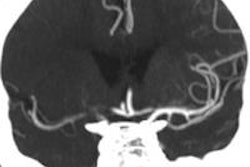Dear AuntMinnie Member,
A North Carolina radiologist has written a medical thriller with an intriguing twist -- a radiologist as a good guy.
The strange but true story comes straight from the pages of Doctored Images, a new novel written by Dr. Robert Sherrier, chief of radiology at Durham Veterans Affairs Medical Center. Dr. Sherrier has long been an aspiring writer, and he finally decided to put pen to paper with his first novel.
Doctored Images highlights the story of Dr. Bo Richards, a second-year resident at a Colorado hospital who runs afoul of a Mexican drug-smuggling ring. At first Bo just wants to get through his residency, but his life soon gets complicated -- even more complicated than the new board exam structure.
Dr. Sherrier sees Doctored Images as unique in that it puts a positive spin on radiologists, one not often found in the mainstream media. He also integrated his own knowledge of radiology into the book's plot. Read our story by clicking here.
Dr. Sherrier has graciously agreed to give away several copies of Doctored Images to AuntMinnie.com members -- just in time for the summer reading season! To enter the giveaway, send us a note by clicking here, and put "Doctored Images" in the subject line.
Why lung nodule size matters
Meanwhile, the world of real-life radiology rolls on. Controversy continues to swirl around CT lung cancer screening, with concern over harms associated with working up suspicious lung nodules becoming a major impediment to more widespread screening in the U.S.
An Italian group has taken the controversy head-on with a paper that proposes using a new protocol for working up suspicious lung nodules. The protocol calls for only working up nodules 5 mm and larger -- compared to the 4-mm threshold used in the landmark National Lung Screening Trial (NLST).
The Italians believe that the larger nodule threshold could achieve similar sensitivity to NLST, while avoiding biopsies and other disadvantages of working up nodules that prove to be benign. Learn more about the technique by clicking here, or visit our CT Digital Community at ct.auntminnie.com.
New tumor assessment criteria
Last but not least, researchers from the U.S. National Institutes of Health (NIH) are coming to believe what many radiologists have found: that volume that may be key in monitoring tumors after treatment.
The NIH team added measurement of tumor volume to existing density measurements, and found that the combination did a better job of measuring patient response to treatment than other criteria, such as the Response Evaluation Criteria in Solid Tumors (RECIST). Read more by clicking here, or visit our Advanced Visualization Digital Community at av.auntminnie.com.




















